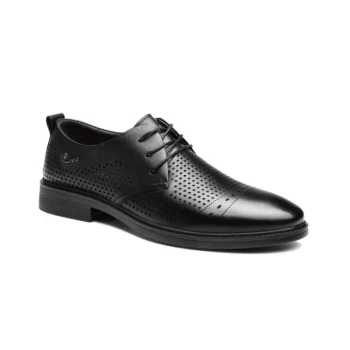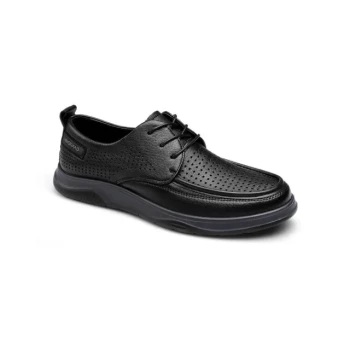When selecting safety footwear, leather is a classic and dominant material for good reason. Its primary advantages are a unique combination of exceptional durability, natural breathability, and an adaptive fit that molds to the wearer's foot over time, providing both rugged protection and long-term comfort.
Leather's reputation for toughness is well-earned, but its true advantage in safety footwear lies in its natural ability to balance robust protection with breathability and personalized comfort. Understanding this balance is the key to selecting the right boot for your specific work environment.
The Core Functional Advantages of Leather
The properties of leather make it uniquely suited for the demanding conditions of occupational footwear. It is not just one feature, but the synergy of several, that makes it a preferred material.
Unmatched Durability and Resistance
Leather is inherently tough, with a dense fiber structure that resists tearing, puncturing, and abrasion. This ruggedness provides a reliable first line of defense in hazardous settings.
Its natural composition ensures it can withstand the daily rigors of a demanding worksite far better than many synthetic alternatives.
Superior Breathability
As a natural material, leather contains thousands of tiny pores. These pores allow air to circulate freely, helping to regulate the temperature inside the shoe and prevent overheating.
This breathability is critical for comfort during long shifts, reducing sweat and the feeling of stuffiness.
Natural Moisture Management
Leather has the remarkable ability to absorb moisture, drawing perspiration away from the foot. This wicking action helps keep feet dry and comfortable.
By managing moisture, leather also helps prevent the growth of odor-causing bacteria, contributing to better foot hygiene.
Adaptive Comfort
Perhaps one of leather's most valued traits is its ability to mold to the wearer's feet over time. Unlike rigid synthetic materials, leather will stretch and shape itself to the unique contours of your foot.
This customization process results in a near-perfect fit, significantly enhancing comfort and reducing the risk of blisters or pressure points.
Understanding the Trade-offs and Limitations
No material is perfect. A clear-eyed assessment of leather's limitations is crucial for making an informed decision.
The Requirement for Regular Care
Leather is a natural skin and requires maintenance. It can dry out, crack, or stain if neglected, compromising both its appearance and its protective qualities.
Regular cleaning and conditioning are necessary to maintain its flexibility, solidity, and resistance to the elements.
Sensitivity to Damage
While durable, leather is not indestructible. It can be sensitive to certain chemicals and can become stiff or damaged if repeatedly soaked and improperly dried.
The Factor of Cost
Genuine, high-quality leather is often more expensive than synthetic materials. The processing and craftsmanship required contribute to a higher price point for premium leather safety shoes.
Making the Right Choice for Your Work Environment
Your specific needs and work conditions should dictate your material choice. Use these points as a guide.
- If your primary focus is maximum durability in a heavy-duty environment: Opt for full-grain leather, as its dense, uncorrected surface offers the best resistance to abrasion and moisture.
- If your primary focus is breathability and comfort for indoor or dry conditions: Consider safety shoes made from split leather or suede, which offer enhanced air circulation.
- If your primary focus is working in consistently wet conditions or with chemicals: You might explore high-quality synthetic alternatives or specially treated leathers designed for superior water and chemical resistance.
Ultimately, understanding the inherent properties of leather empowers you to choose footwear that ensures both safety and comfort throughout your workday.
Summary Table:
| Advantage | Key Benefit | Ideal For |
|---|---|---|
| Durability | Resists abrasion, tearing, and punctures | Heavy-duty industrial work |
| Breathability | Natural pores allow air circulation for comfort | Long shifts, indoor/dry conditions |
| Moisture Management | Wicks away sweat to keep feet dry | Improved foot hygiene and comfort |
| Adaptive Fit | Molds to the wearer's foot over time | Enhanced long-term comfort, reduced blisters |
Ready to experience the superior protection and comfort of leather safety footwear?
As a large-scale manufacturer, 3515 produces a comprehensive range of high-quality leather safety shoes and boots for distributors, brand owners, and bulk clients. We combine durable materials with expert craftsmanship to deliver footwear that meets the highest safety standards.
Contact our team today to discuss your specific needs and get a custom quote!
Related Products
- Premium KPU Athletic Safety Shoes for Wholesale
- Custom Manufactured Air Cushion Leather Business Shoes for Wholesale
- Wholesale Comfort Leather Business Shoes with Dial Lacing System
- Wholesale Durable & Breathable Training Shoes for Custom Brands
- Factory Direct Wholesale Leather Comfort Shoes with Dial Closure
People Also Ask
- What does a green triangle symbol on safety footwear mean? Your Guide to Maximum Puncture & Impact Protection
- What types of workplace hazards require protective footwear? Essential Guide for Workplace Safety
- What are the EN ISO 20345 norms for safety shoes? A Guide to Choosing the Right Protection
- How is puncture resistance evaluated in footwear soles? Balance Protection, Comfort & Safety
- What materials are used in the construction of these boots? A Guide to Velour Leather, Textile & PU Soles



















